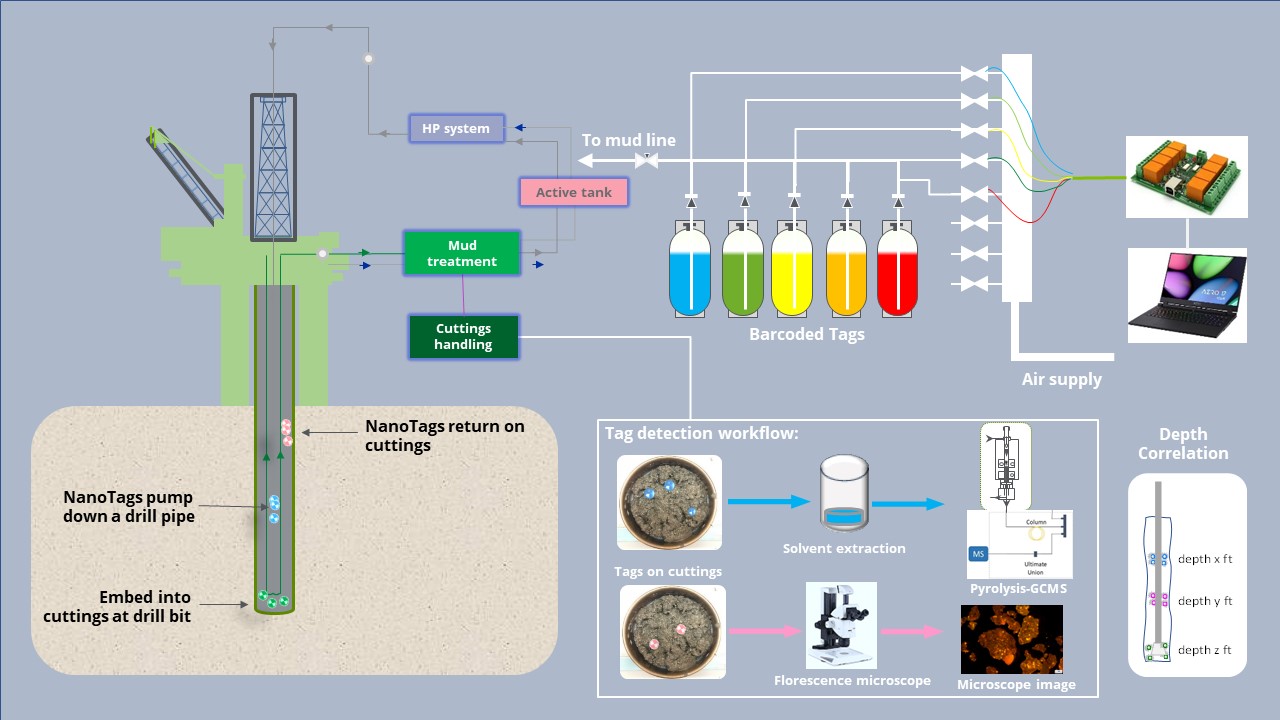2023 AIChE Annual Meeting
(252e) Nanotags for Improved Cutting Depth Correlation
Authors
Despite its potential benefits, advanced mud logging deployment has historically been plagued by poor data quality due to uncertainties in drill-cutting depth determination. The accuracy of cuttingsâ depth assessment depends on a number of factors, including wellbore mud hydraulics, hole cleaning, and an accurate lag time of the cuttings. However, the lag time can be difficult to determine accurately, as it is based on the cuttings' return trip up the annulus and may be affected by systematic overgauge drilling, hole caving, or spiraling factors that are not accounted for in the mud-logger's software. Inaccuracies can also arise from gravitational debris accumulation, hydraulics, and hole cleaning, especially in long horizontal sections. When the cuttings' return trip lasts half an hour or longer, depth uncertainties can be significant, ranging from ten to twenty feet or more. Furthermore, inaccurate labeling of collected cuttings or mis-sorting during handling can exacerbate these errors.
To address these challenges, we have developed a groundbreaking technology that enables accurate tagging of drill cuttings using barcoded NanoTags during drilling operations. This innovative depth correlation system comprises three components: barcoded NanoTags, an extraction process, and a detection method that can precisely and uniquely detect the tags present on the drill cuttings. The tags are injected into the water-based mud at ppm level as the tag enters the drillstring and label the freshly generated cuttings at the drillbit. The tagged cuttings are collected over the shale shaker at the estimated tagsâ arrival time, and the lag time of the tags is determined by their downward-trip time through the dimensionally accurate drill pipe or coil ID. This method significantly reduces depth-correlation uncertainty to +/- 2 ft compared to conventional method that estimates the lag time using the cuttingâs return trip up the annulus.
The NanoTags are custom-polymerized nanoparticles that range in size from 20-60 nm. The NanoTags, synthesized using an emulsion polymerization, are compatible with water-based drilling fluids, stable in subsurface conditions, and have a shelf life of more than one year at ambient conditions. Some NanoTag formulations also contain a fluorescent dye. The tags are isolated from the cuttings in the lab using a workflow comprised of water washing, solvent extraction, and thermal separation. Since the NanoTags generate unique mass spectral signals, we can detect them unambiguously at µg levels using a GC/MS equipped with a pyrolyzer (Py-GCMS). The fluorescent tags on cuttings or in mud are visible under a portable fluorescence microscope.
Furthermore, we have customized a robotic platform, built by Chemspeed Technologies, to process and prepare the field cuttings for analysis. The Chemspeed platform can weigh cuttings, add solvent, filter the cuttings, and vacuum dry 16 different types of cuttings, or 48 samples total when measured in triplicate, within 24 hours. These steps recover the tags from the field cuttings for final analysis using pyrolysis-GCMS. The customized automation platform significantly reduces the time and manpower necessary to prepare the cuttings for characterization.
We have demonstrated the effectiveness of the NanoTagging technology during two field tests performed in 2019 and 2022 in Saudi Arabia during the drilling of two different vertical gas wells. Both field tests confirm the successful tagging of the drill cuttings with our tags and show the improved depth correlation of the cuttings. Furthermore, we designed an air-powered rapid-multiplexing tags injection apparatus to deliver sharp pulsed injection of each tag continuously to the mud during the 2nd field test using pre-programmed injection times and flow rates for each tag.
The NanoTags for drill-cuttings depth correlation technology improves the current mud logging process and is cost-effective, straightforward, and environmentally friendly. This technology allows oil and gas operators to improve the quality of lithological and petrophysical analyses, enhance formation evaluation and geosteering practices, and control well placement with mud logging, thus helping to maximize oil recovery. The automation of the field dispensing of the different NanoTag barcodes into the mud and the automation of the lab extraction and detection workflow in combination with optical detection methods could make the tagging process a routine operation available for improving mud-logging data quality in the field.
